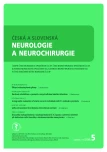Taste strips – the method of a self-administered taste function test
Authors:
P. Brothánková 1,2; J. Vodička 1,2; V. Žilková 1,3
Authors‘ workplace:
Fakulta zdravotnických studií, Univerzita Pardubice
1; Klinika otorinolaryngologie, a chirurgie hlavy a krku, Nemocnice, Pardubického kraje, a. s., Pardubická, nemocnice
2; Kardiochirurgická klinika, LF UK a FN Hradec Králové
3
Published in:
Cesk Slov Neurol N 2020; 83/116(5): 531-534
Category:
Original Paper
doi:
https://doi.org/10.14735/amcsnn2020531
Overview
Aim: The aim of the study was to develop a procedure of assessment of the taste function, which can be done without any assistance (self-administrated taste function test). Function of taste was evaluated by using Taste strips with assisted gustatory testing (wet method) and by self-administrated test (dry method). The results were compared with each other.
Methods: 115 participants were included in the study. The first group included 85 healthy persons with the average age 39 years (18–73 years), the second group 30 patients with the average age 59 years (41–76 years). The sense of taste was tested by Taste strips. in which the taste stimulants are applied in the form of a solution to the filter paper, and by a new developed test designed for the self-examination of the taste by the dry method, when the taste stimulants on the filter paper are already dry.
Results: Comparing the examination of taste by an erudite person to the self-administered taste test, there was no significant difference in score (10.1 vs. 10.0 points; P = 0.52). In the case of the assisted Taste strips test, the healthy participant scores were higher than the patients scores (10.4 vs. 9.4 points; P = 0.02). In the case of the self-administered taste test, the healthy participant scores were higher than patients scores as well (10.4 vs. 9.1 points; P = 0.001).
Conclusion: The taste strips test (dry method) can be performed by patients themselves. The self-administered procedure is not limited to time, reducing the demands on the medical staff and decreasing the risk of infection in the time of communicable diseases.
Keywords:
gustatory – Taste strips – assessment of taste – self-administered
Sources
1. Ehler E, Vodička J, Faitlová H. Poruchy čichu a chuti u polyneuropatií. Neurol Praxi 2015; 16 (2): 88–91.
2. Liu DT, Besser G, Oeller F et al. Bitter taste perception of the human tongue mediated by quinine and caffeine impregnated taste strips. Ann Otol Rhinol Laryngol 2020; 129 (8): 813–820. doi: 10.1177/0003489420906187.
3. Fark T, Hummel C, Hähner A et al. Characteristics of taste disorders. Eur Arch Otorhinolaryngol 2013; 270 (6): 1855–1860. doi: 10.1007/s00405-012-2310-2.
4. Yan CH, Faraji F, Prajapati DP et al. Association of chemosensory dysfunction and Covid-19 in patients presenting with influenza-like symptoms. Int Forum Allergy Rhinol 2020; 10 (7): 806–813. doi: 10.1002/alr.22579.
5. Lechien JR, Chiesa-Estomba CM, De Siati DR et al. Olfactory and gustatory dysfunctions as a clinical presentation of mild-to-moderate forms of the coronavirus disease (COVID-19): a multicenter European study. Eur Arch Otorhinolaryngol 2020; 277 (8): 225–2261. doi: 10.1007/s00405-020-05965-1.
6. Landis BN, Welge-Luessen A, Brämerson A et al. „Taste Strips“ – a rapid, lateralized, gustatory bedside identification test based on impregnated filter papers. J Neurol 2009; 256 (2): 242–248. doi: 10.1007/s00415-009-0088-y.
7. Vodička J, Pecková L, Kopal A. Vyšetření čichu u neurologických onemocnění pomocí Testu parfémovaných fixů. Cesk Slov Neurol N 2010; 73/106 (1): 45–50
8. Vodička J, Faitlová H. Příručka pro praxi: Poruchy čichu. [online]. Dostupné z URL: http: //otorinolaryngologie.cz /dokumenty/PPP_cich.pdf.
9. Vodička J, Faitlová H. Poruchy čichu a chuti. 1. vyd. Havlíčkův Brod: Tobiáš 2012.
10. Welge-Lüssen A, Dörig P, Wolfensberger M et al. A study about the frequency of taste disorders. J Neurol 2011; 258 (3): 386–392. doi: 10.1007/s00415-010-5763-5.
11. Iannilli E, Knaapila A, Cecchini MP et al. Dataset of verbal evaluation of umami taste in Europe. Data Brief 2020; 28 : 105102. doi: 10.1016/j.dib.2019.105102
12. Wolf A, Varga L, Wittibschlager L et al. A self-administered test of taste function using „Taste Strips“. Int Forum Allergy Rhinol 2016; 6 (4): 362–366. doi: 10.1002/alr.21681.
Labels
Paediatric neurology Neurosurgery NeurologyArticle was published in
Czech and Slovak Neurology and Neurosurgery

2020 Issue 5
- Hope Awakens with Early Diagnosis of Parkinson's Disease Based on Skin Odor
- Metamizole at a Glance and in Practice – Effective Non-Opioid Analgesic for All Ages
- Memantine Eases Daily Life for Patients and Caregivers
- Metamizole vs. Tramadol in Postoperative Analgesia
- Memantine in Dementia Therapy – Current Findings and Possible Future Applications
Most read in this issue
- Diffuse low grade gliomas
- Respiratory rehabilitation in patients with amyotrophic lateral sclerosis
- Amnesia Light and Brief Assessment (ALBA) test – the second version and repeated examinations
- Neurorehabilitation in patients with amyotrophic lateral sclerosis
